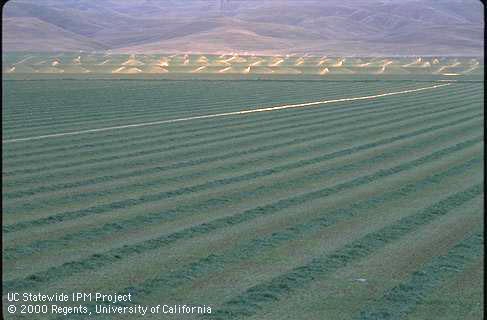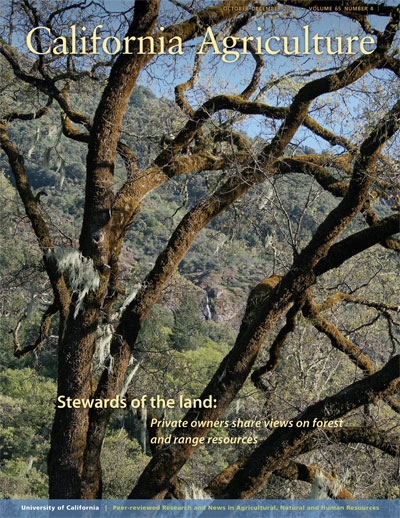Posts Tagged: Alfalfa
New UC studies examine cost of producing beef, alfalfa hay, corn silage, rice, prunes, raspberries and avocados
New studies showing production costs for beef, alfalfa hay, corn silage, rice, prunes (dried plums), raspberries and avocados (conventional and organic) are now available from the University of California Cooperative Extension.
Each analysis is based upon hypothetical farm operations using practices common in the region. Input and reviews were provided by farm advisors, researchers, growers, farm accountants, pest control advisers, consultants and other agricultural associates.
Assumptions used to identify current costs for the individual crops, material inputs, cash and non-cash overhead are described. A ranging analysis table shows profits over a range of prices and yields. Other tables show the monthly cash costs, the costs and returns per acre, hourly equipment costs, and the whole farm annual equipment, investment, and business overhead costs.
The new studies are:
Sample Costs for Finishing Beef Cattle on Grass, 2012, Sacramento Valley, by Larry C. Forero, Roger S. Ingram, Glenn A. Nader, Karen M. Klonsky, and Richard L. De Moura.
Sample Costs to Produce Corn Silage, 2012, San Joaquin Valley by Carol A. Frate, Brian H. Marsh, Karen M. Klonsky, and Richard L. De Moura.
Sample Costs to Produce Rice, 2012, Sacramento Valley by Christopher A. Greer, Randall G. Mutters, Luis A. Espino, Paul Buttner, Karen M. Klonsky, Richard L. De Moura and Kabir P. Tumber.
Sample Costs to Establish a Prune Orchard and Produce Prunes, 2012, Sacramento Valley by Richard P. Buchner, Joseph H. Connell, Franz J. Niederholzer, Carolyn J. DeBuse, Karen M. Klonsky, and Richard L. De Moura.
Sample Costs to Produce Fresh Market Raspberries, 2012, Central Coast by Mark Bolda, Laura Tourte, Karen M. Klonsky, and Richard L. De Moura.
Avocado Sample Establishment and Production Costs and Profitability Analysis for Ventura, Santa Barbara and San Luis Obispo Counties, 2011, Conventional Production Practices and Avocado Sample Establishment and Production Costs and Profitability Analysis for San Diego and Riverside Counties, 2011. Conventional Production Practices by Etaferahu Takele, Gary Bender and Mao Vue.
Avocado Sample Establishment and Production Costs and Profitability Analysis for Ventura, Santa Barbara and San Luis Obispo Counties, 2011, Organic Production Practices and Avocado Sample Establishment and Production Costs and Profitability Analysis for San Diego and Riverside Counties, 2011, Organic Production Practices by Etaferahu Takele, Gary Bender and Mao Vue.
All cost of production studies are available online at http://coststudies.ucdavis.edu, at UC Cooperative Extension offices or by calling (530) 752-3589. For additional information on the studies, contact Richard De Moura at rdemoura@ucdavis.edu in the UC Davis Department of Agricultural and Resource Economics.
UC, CSU team up on agricultural, environmental research projects
Leadership of California’s higher education systems made the funding available to jointly address issues in agriculture, natural resources and human sciences. Project criteria include collaborative research, teaching, or course development; development of student internship opportunities; and workshops, conferences, and symposia. Eight projects totaling more than $79,500 were selected from 30 proposals submitted.
“These research projects will help leverage limited resources to produce quick results on important issues in California,” said Neal Van Alfen, dean of the College of Agricultural and Environmental Sciences at UC Davis. “They are also building stronger connections among researchers throughout the state and providing hands-on learning opportunities for students.”
Researchers involved in this year’s projects are from UC Davis, UC Berkeley and California State University campuses at Chico, Fresno, Humboldt, Pomona, Sonoma, San Marcos and San Luis Obispo. The awarded projects, with principal investigators, are listed below:
- “Estimating residential water demand functions in urban California regions” — Economists from UC Berkeley and Cal Poly San Luis Obispo will estimate residential water demand of municipalities and water companies that serve 19 million people in the Bay Area and Southern California. (Maximilian Auffhammer, Stephen Hamilton)
- “Reintroduced mammals and plant invaders as key drivers of ecosystem processes in coastal and interior grasslands” — Researchers from Sonoma State University and UC Davis will study how reintroducing tule elk and reducing invasive Harding grass affects the availability of soil nutrients and the composition of plant communities. (Caroline Christian, J. Hall Cushman, Valerie Eviner)
- “Genetics of plant defense responses to pesticides and spider mites on grapes” — Scientists from UC Davis and Cal Poly San Luis Obispo will conduct laboratory, greenhouse and field studies to learn more about factors affecting grapevine response to spider mites, including cultivar resistance, drought impact and pesticide exposure. (Michael Costello, Richard Karban, Andrew Walker, Jeffrey Wong)
- “Defining the functions of polyphenol oxidase in walnut” — Through genetic analysis, researchers at CSU San Marcos and UC Davis seek to learn more about an enzyme involved in the postharvest browning of cut or bruised fruit. (Matthew Escobar, Monica Britton, Abhaya Dandekar)
- “Modeling the costs of hazardous fuel reduction thinning treatments and removal of woody biomass for energy” — Researchers from Humboldt State University, UC Davis, and the U.S. Forest Service will develop a model to estimate the costs of removing hazardous wildland fuels with different equipment and systems over a wide range of forest stand, site and road conditions. (Han-Sup Han, Bruce Hartsough)
- “Restoration of pollinator communities and pollination function in riparian habitats” — Researchers from California State University, Chico, and UC Davis will characterize native pollinator communities at restored riparian habitats within the Central Valley and test whether successful restoration of pollinator communities also leads to restoration of pollination. (Christopher Ivey, Neal Williams)
- “Estimating alfalfa’s impact on regional nitrogen budgets and nitrate leaching losses in the Central Valley of California” — Researchers from California State University, Fresno, and UC Davis will collect alfalfa and non-legume plants from irrigated fields and also identify San Joaquin Valley farm sites for a multi-year study of alfalfa’s impact on regional nitrogen budgets, groundwater nitrate leaching, and nitrogen requirements of rotation crops. (Bruce Roberts, Stuart Pettygrove, Daniel Putnam)
- “Community and ecosystem response to elevated nitrogen in managed grassland ecosystems” — Restoration ecologists from Cal Poly Pomona and UC Berkeley will investigate how elevated nitrogen levels affect competition among native and exotic plant species with regard to fuel characteristics at UC’s South Coast Research and Extension Center. (Erin Questad, Katharine Suding)
Reports on project outcomes are expected in December 2012.
Cell communication system prevents overirrigation of alfalfa
Scientists have developed a low-cost, high-tech system that predicts when flood irrigation will approach the end of an alfalfa field, then signals to turn it off — an innovation that could save enormous amounts of runoff from the state’s alfalfa fields.
Cultivated on 1.1 million acres, alfalfa is the largest consumer of water among all crops in California, accounting for up to 27 percent of the state’s irrigation water use. Alfalfa is usually flood irrigated, often leading to overirrigation. Water is pumped in at the top of field rows and flows down to the end. If the flow is not turned off before it reaches the bottom, substantial runoff occurs.
The new system employs sensors to track the advance of water down a field, a model that predicts when water will reach the tail end of the field, and a cellular communications system that sends a cell phone alert to the irrigator to turn off the water. It was field-tested during two seasons on the UC Davis campus; the results — zero tail water drainage from the trial fields compared with thousands of liters of runoff from control fields — are reported in the October–December 2011 issue of the University of California’s California Agriculture journal.
“Under current practice, the alfalfa irrigator makes several trips to the field to determine when the wetting front has reached a certain distance from the bottom end of the check [irrigation channel] before turning off the irrigation,” writes lead author Rajat Saha, assistant engineer for MBK Engineers in Sacramento. “Even making several trips, the irrigator may miss the wetting front advance, which results in excessive tail water drainage.”
The system, developed by Saha and coauthors at UC Davis while Saha was a UC Davis graduate student, was successfully demonstrated to dozens of farmers last year at the Alfalfa Field Day. The components are relatively inexpensive: the sensors (three per check) cost about $25 each; the data logger and modem, which can be easily moved from one location to another to reduce the initial installation investment, about $500 and $200, respectively.
If the new system, which may be commercially available in early 2012, were used for the typical five irrigations per alfalfa season, “water savings could be about 35,000 to 60,000 liters per acre,” Saha reports.
The research article, and the entire October–December 2011 issue, can be downloaded at http://californiaagriculture.ucanr.org.
California Agriculture is the University of California’s peer-reviewed journal of research in agricultural, human and natural resources. For a free subscription, go to: http://californiaagriculture.ucanr.org, or write to calag@ucdavis.edu.
WRITERS/EDITORS: To request a hard copy of the journal, email crllopez@ucdavis.edu.



